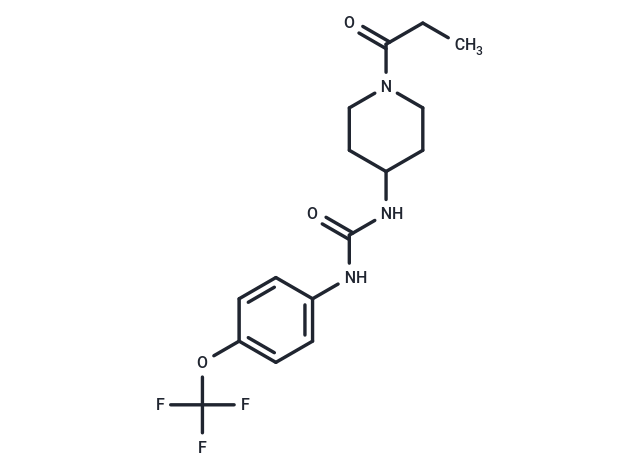Shopping Cart
- Remove All
 Your shopping cart is currently empty
Your shopping cart is currently empty

TPPU is a potent inhibitor of both human and mouse sEH (IC50 of 3.7 and 2.8 nM, respectively)

| Pack Size | Price | Availability | Quantity |
|---|---|---|---|
| 1 mg | $30 | In Stock | |
| 5 mg | $64 | In Stock | |
| 10 mg | $106 | In Stock | |
| 25 mg | $198 | In Stock | |
| 50 mg | $328 | In Stock | |
| 100 mg | $538 | In Stock | |
| 1 mL x 10 mM (in DMSO) | $71 | In Stock |
| Description | TPPU is a potent inhibitor of both human and mouse sEH (IC50 of 3.7 and 2.8 nM, respectively) |
| Targets&IC50 | sEH (mouse):2.8 nM, sEH (human):3.7 nM |
| In vivo | TPPU and two 4-(cyclohexyloxy) benzoic acid urea sEHIs displayed high plasma concentrations (>10 × IC(50)), when dosed orally at 0.3 mg·kg(-1). Although the 4-(cyclohexyloxy) benzoic acid ureas were more potent against monkey sEH than piperidyl ureas (TPAU and TPPU), the latter compounds showed higher plasma concentrations and more drug-like properties. The C(max) increased with dose from 0.3 to 3 mg·kg(-1) for TPPU and from 0.1 to 3 mg·kg(-1) for TPAU, although it was not linear over this range of doses. As an indication of target engagement, ratios of linoleate epoxides to diols increased with TPPU administration[1]. |
| Animal Research | PK parameters of 11 sEHIs in cynomolgus monkeys were determined after oral dosing with 0.3 mg/kg. Their physical properties and inhibitory potency in hepatic cytosol of cynomolgus monkeys were examined. Dose-dependent effects of the two inhibitors 1-trifluoromethoxyphenyl-3-(1-propionylpiperidin-4-yl) urea (TPPU) and the related acetyl piperidine derivative, 1-trifluoromethoxyphenyl-3-(1-acetylpiperidin-4-yl) urea (TPAU), on natural blood eicosanoids[1] |
| Molecular Weight | 359.34 |
| Formula | C16H20F3N3O3 |
| Cas No. | 1222780-33-7 |
| Smiles | CCC(=O)N1CCC(CC1)NC(=O)Nc1ccc(OC(F)(F)F)cc1 |
| Relative Density. | 1.31 g/cm3 (Predicted) |
| Storage | Powder: -20°C for 3 years | In solvent: -80°C for 1 year | Shipping with blue ice. | ||||||||||||||||||||||||||||||
| Solubility Information | DMSO: 28 mg/mL (77.92 mM), Sonication is recommended. | ||||||||||||||||||||||||||||||
Solution Preparation Table | |||||||||||||||||||||||||||||||
DMSO
| |||||||||||||||||||||||||||||||

Copyright © 2015-2025 TargetMol Chemicals Inc. All Rights Reserved.